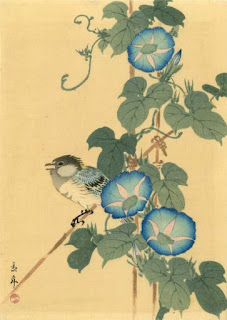Dear Haijin, visitors and travelers,
Welcome at the dawn of our new Carpe Diem month March. This month all our prompts are classical Japanese kigo (seasonwords) of Spring. Seasonwords are specific words which are referring to a season. It's one of the basic rules that in every haiku a seasonword is used. So maybe we go this month back to basic, or not of course (smiles).
As you maybe know I am not a fan of the counted verse with 3-5-3 or 5-7-5 syllables. I write my haiku in the so called Kanshicho-style. In this style (initiated by Matsuo Basho (1644-1694), the most well known haiku master) the syllables-count isn't that strict. In this style Basho used during 1683-1685 he was longing for renewal of haiku and longing for the Chinese way of poetry writing. So, as Basho once said, "learn the rules and forget them immediately", and that's what I do. Haiku writing (or composing) comes right from the heart and it's not bound to rules. Enjoy composing haiku.
For starters a haiku written by Matsuo Basho:
haru no yo ya komoribito yukashi do no sumi
one evening in spring
in a corner of the Hall
a mysterious suppliant
(c) Basho
R.H.Blyth, the author of a four volume series about haiku says about this haiku:
[...] This haiku was composed at Hase, in Yamato, what is now Nara Prefecture, at the temple known as Hasedera, or Kwan-nondo, or Chokokuji. In the Genji Monogatari and the Tsure-zuregusa we find frequent references to pilgrimages to this temple, especially by women to the Kwannon enshrined there.
One night Basho went to the temple to worship, and looking round saw in one corner of the great hall a man or woman kneeling there in supplication before the image of Kwannon. A few candles burning here and there, the hall is full of shadows. Outside, the cherry blossoms are falling through the darkness; here in the dusk, the silent, motionless form of the suppliant [...] (Source: Haiku Vol. 2 Spring, page 397 - R.H.Blyth)
 |
| Credits: Kwannon |
 |
| Credits: Kwannondo |
What do we have more in this new Carpe Diem month? For our Carpe Diem Specials I have chosen haiku written by Onitsura (1660-1738), a haiku master and contemporary of Basho, who wrote wonderful haiku. For example this one on 'The Great Morning' (the morning of New Year's Day):
oashita mukashi fukinishi matsu no kaze
The Great Morning:
winds of long ago
blow through the pine-trees
(c) Onitsura
 |
| Onitsura (1660-1738) |
Onitsura was a contemporary of Basho and maybe the knew each other. I think they knew each other and Onitsura was a 'follower' of Basho's way of writing and composing haiku. In the haiku I gave here-for one can read, feel and see the simpleness and timelessness which is clearly a Buddhistic way of looking to the world. (Zen)Buddhism is also one of the pillars of haiku. In very haiku you can see that and hidden deep inside every haiku you will find in some way (Zen)Buddhism.
OK ... today is our 'kick-off' of our sixth Carpe Diem month. And this month all our prompts are classical Japanese kigo. Today we share haiku on a kigo of early Spring, Risshun (which means: coming of Spring).
An example of a kidai (a headword followed by specific kigo) for the season of spring is risshun (beginning of spring). Kigo under this headword are haru tatsu (spring begins) and haru kuru (spring comes).
For example a haiku written by Shoha (* - 1771) in which he used haru tatsu (Spring begins):
haru tatsu ya shizuka ni tsuru no ippo yori
Spring begins
quietly,
from the stork's one pace
(c) Shoha
The stork, as a symbol of longevity, is closely associated with the New Year (in Japanese tradition the start of Spring), and as it quietly lifts up one foot and quietly places it down again, it is in harmony with our feeling of tranquility and new born nobility. Do you feel the Zen in this one?
It took me a while to write a haiku on this kigo, because I loved to touch that Zen with it ... after a while I came up with this new haiku:
cherry blossom opens
without disturbing the pigeons
building their nest
quietly
cherry blossoms bloom -
drizzling day
That was, my dear friends, the first episode of our new Carpe Diem month. I hope you enjoyed the read. And I hope that you all are inspired to write haiku on Risshun. Enjoy your composing.
This prompt will stay on 'till March 2nd 11.59 AM (CET) and I will post our new episode, Saekaeru (returning cold), later on today around 10.00 PM.





















